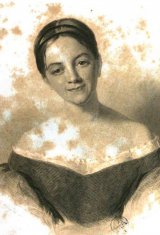Analysis of Benares
Letitia Elizabeth Landon 1802 (Chelsea) – 1838 (Cape Coast)
City of idol temples, and of shrines,
Where folly kneels to falsehood—how the pride
Of our humanity is here rebuked !
Man, that aspires to rule the very wind,
And make the sea confess his majesty ;
Whose intellect can fill a little scroll
With words that are immortal ; who can build
Cities, the mighty and the beautiful:
Yet man, this glorious creature, can debase
His spirit down, to worship wood and stone,
And hold the very beasts which bear his yoke,
And tremble at his eye, for sacred things.
With what unutterable humility
We should bow down, thou blessed Cross, to thee!
Seeing our vanity and foolishness,
When, to our own devices left, we frame
A shameful creed of craft and cruelty.
Benares may be called the Rome of Hindostan, being the sacred city, the centre of the Hindoo religion. Bishop Heber states, that " no Europeans live in the town, nor are any of the streets wide enough to admit a wheel carriage." The streets are crowded with " the sacred bulls devoted to Seeva, tame and familiar as mastiffs, walking lazily up and down, and lying across them. Monkeys sacred to Hunooman, the divine ape who conquered Ceylon, are in some parts of the town equally numerous, clinging to all the roofs, and putting their heads or hands into every fruiterer's or confectioner's shop, and snatching the food from the children at their meals. Fakirs' houses occur at every turn, adorned with idols, and sending out an unceasing tinkling of vinas, bugals, and other discordant instruments : while religious mendicants, of every Hindoo sect, offering every conceivable deformity, which chalk, disease, matted locks, distorted limbs, and disgusting attitudes of penance, can shew, literally line the principal streets." "The houses are painted of a deep red, and covered with paintings, in gaudy colours, of flower-pots, men, women, bulls, elephants, gods and goddesses, in all their many-headed, many-handed, many-weaponed varieties." " The number of temples is very great, mostly small, and stand like shrines in the angles of the streets. Many of them are entirely covered over with beautiful and elaborate carvings of flowers, animals, and palm branches, equalling in minuteness and richness the best specimens I have seen of Gothic or Grecian architecture." Tavernier mentions a belief of the Brahmins, whence the classic allegory of the golden, silver, brazen, and iron ages originated. " This holy city," say they, " was originally built of gold, but, for the sins of mankind, it was successively degraded to stone, brick, and clay."
| Scheme | XXXXAXXXXXXXAAXXA X |
|---|---|
| Poetic Form | |
| Metre | 1011010011 110111101 11001001101 11010110101 0101011100 110110101 1111010111 1001000100 11110010101 1101110101 0101011111 0101111101 1110100 111111111 10101000100 11101010111 010111010 1111011110010100101010101010111010100111101011011010110011101010101011100101110100101010011101011001111001101110110010010110101011110110011110100110101111100111001011100101101010011101001010010101110011100100010001001101110101001010110111000101001010110101101011001011101110110010100011101010101010100010110110110101110010101101110100101011000010101101000110101010011001111101101001000100011011010100101010100101001001101011101000111110111111010001011101 |
| Characters | 2,526 |
| Words | 425 |
| Sentences | 15 |
| Stanzas | 2 |
| Stanza Lengths | 17, 1 |
| Lines Amount | 18 |
| Letters per line (avg) | 112 |
| Words per line (avg) | 24 |
| Letters per stanza (avg) | 1,007 |
| Words per stanza (avg) | 212 |
Font size:
Citation
Use the citation below to add this poem analysis to your bibliography:
Style:MLAChicagoAPA
"Benares" Poetry.com. STANDS4 LLC, 2024. Web. 26 May 2024. <https://www.poetry.com/poem-analysis/44934/benares>.


Discuss this Letitia Elizabeth Landon poem analysis with the community:
Report Comment
We're doing our best to make sure our content is useful, accurate and safe.
If by any chance you spot an inappropriate comment while navigating through our website please use this form to let us know, and we'll take care of it shortly.
Attachment
You need to be logged in to favorite.
Log In